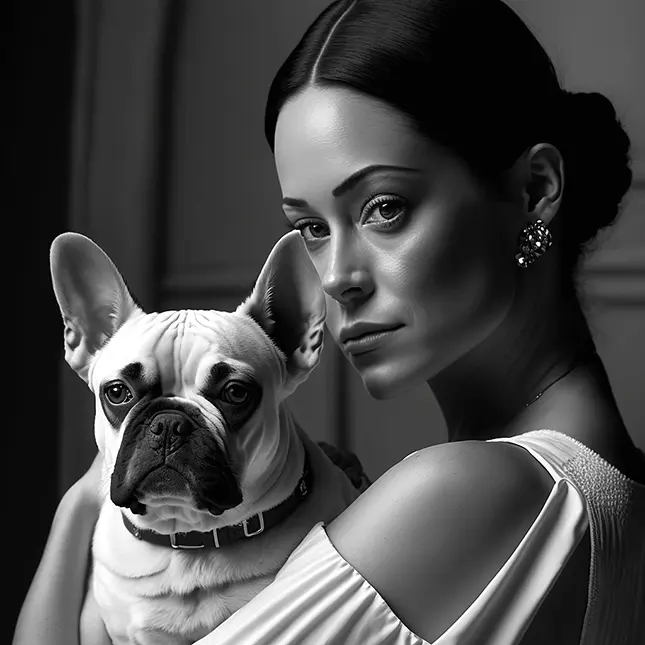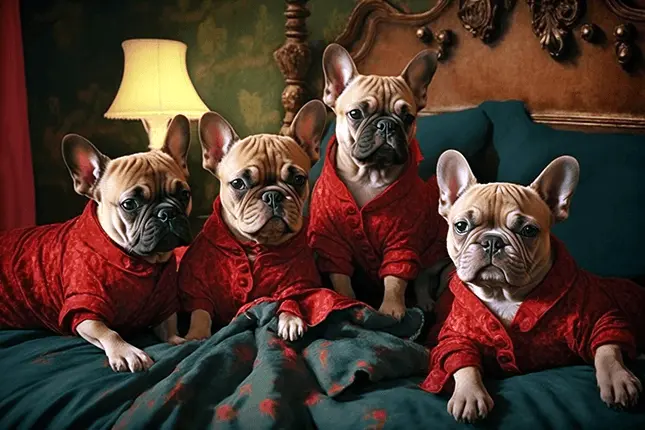FRENCH BULLDOG
The French Bulldog, despite its Gallic (a.k.a. French) name, is a breed of both British and French origin [1]. It has its ancestral roots in the Toy Bulldog of Britain in the 1850s.
During the Industrial Revolution, the Toy Bulldog was introduced to Northern France where it is thought to have been crossed with other brachycephalic (short-muzzled) breeds, resulting in the French Bulldog breed as it is known today.
In the late 19th century, the breed returned to Britain and was formally recognized by the Kennel Club (KC) in 1906. The breed is currently the second most commonly registered KC breed in the UK, exceeded only by the Labrador Retriever in popularity [2].
- March 22, 2023
- Dagmara Mach
The popularity of the French Bulldog has dramatically increased in recent years, with an over thirty-fold increase in registrations from 2007 to 2016.
This increase in popularity is thought to be driven by celebrity ownership of French Bulldogs and media exposure, the rise in popularity of the French Bulldog has been attributed to its features in movies and media, and driven by celebrity ownership. [3][4].
The distinctive appearance of the French Bulldog breed, including its brachycephalic (short-muzzled) features and adorable bat ears [5][6].
However, the brachycephalic conformation of the breed, characterized by its short muzzle and wide, prominent eyes, is associated with several health problems, including brachycephalic obstructive airway syndrome, dystocia, corneal ulceration, patellar luxation, and a range of spinal diseases.
Despite these health concerns, the French Bulldog remains a popular breed, with many people drawn to its unique appearance.
The UK KC initially listed the French Bulldog as a category 3 breed (the highest category) in its “Breed Watch” system due to its health concerns.
Since 2013, the breed has been moved to category 2, but a range of health points of concern remain for special attention by show judges.

French bulldogs, also known as “Frenchies,” are a breed of domestic dog that originated in England and came to France in the 19th century. They were originally bred for bull-baiting, a popular sport in which bulldogs were used to grab and hold onto the noses of bulls.
However, when bull-baiting was banned in the 19th century, bulldogs became less popular, and a smaller, more companionable variety was developed. In France, these dogs were called “Bouledogues Français,” or French bulldogs, and were favored by Parisian artists and intellectuals.
They were later brought to the United States, where they became popular as a fashionable pet among the wealthy. Today, French bulldogs are one of the most popular breeds in the world and are known for their friendly and affectionate personalities.
Contrary to its name, the French bulldog, or Frenchie, is thought to have originated in England, not France.
The breed was created by breeding bulldogs with terriers to produce a smaller, more compact version of the bulldog. This new breed was popular among the working-class in England, particularly among those who worked in the textile mills in the city of Nottingham.
However, it was in France where the breed became especially popular and gained its distinctive “French” moniker. The dogs were initially brought to France by English lacemakers and became a favorite among the Parisian upper class.
From there, the breed spread throughout Europe and eventually to other parts of the world, including the United States.
Bull-baiting was a popular sport in England during the medieval period and was later adopted in France. In this sport, bulldogs were trained and bred to grab onto the noses of bulls and hold them down.
The goal was to immobilize the bull, making it easier for the bull to be butchered for meat. Bulldogs were chosen for this sport because of their powerful jaws and tenacity, which allowed them to hold onto the bull despite its attempts to shake them off.
Bull-baiting was eventually banned in the 19th century due to concerns about animal welfare and cruelty, which led to a decline in popularity of bulldogs. With the sport no longer a driving force behind their breeding, bulldogs were developed into smaller, more companionable dogs. French bulldogs were developed in France as a smaller, more adaptable version of the bulldog, suited to city living and as a companion animal. They were highly prized by artists and intellectuals in Paris, who admired the breed’s unique appearance and friendly personality.
It’s worth noting that today’s French bulldogs are much different from their bull-baiting ancestors. They are much smaller and no longer have the powerful jaws and aggressive temperament that were necessary for bull-baiting. Instead, they are known for being friendly, affectionate, and playful, making them popular pets around the world.
there are some historical records that describe the life of French bulldogs in the 19th century, especially among artists and intellectuals in Paris. These records describe French bulldogs as being fashionable pets that were often carried around by their owners and were popular at social gatherings.
As for the ban on bull-baiting, it was banned in England in 1835 as part of the Cruelty to Animals Act. This law made it illegal to use dogs for bull-baiting or other forms of animal fighting, which led to a decline in the popularity of bulldogs. The ban on bull-baiting was adopted in other countries, including France, around the same time or soon after.
It’s worth noting that the ban on bull-baiting was a turning point in the history of bulldogs and French bulldogs. With bull-baiting no longer driving their breeding and development, bulldogs evolved into smaller, more companionable dogs. French bulldogs, in particular, became popular among artists and intellectuals in Paris, who appreciated their unique appearance and friendly personality. This set the stage for the development of the French bulldog as a companion animal, a role that they continue to excel in today.
French bulldogs were first exported from France to other countries in the late 19th century. The breed’s unique appearance and friendly personality quickly made it popular among breeders and pet owners in England, the United States, and other countries.
One of the first countries to import French bulldogs outside of France was England, where they were first brought over in the 1880s. The breed quickly became popular among the fashionable set in London and was soon being exported to other countries, including the United States.
The French bulldog first appeared in the United States in the late 1800s and quickly gained popularity among pet owners and breeders. The breed was recognized by the American Kennel Club (AKC) in 1898, and the first French bulldog club was formed in the United States in 1897.
Over the next several decades, French bulldogs became popular in many other countries around the world, including Canada, Australia, and New Zealand. Today, they are one of the most popular breeds in the world and can be found in homes and families in many countries.
There is historical evidence of the export and import of French bulldogs from the late 19th century. There are records of the breed being imported and exported between France, England, and the United States, as well as other countries. This includes records of breeders, pedigrees, and breeding programs, as well as records from dog shows and other events where the breed was featured.
In addition to these official records, there are also many photographs, paintings, and illustrations from the late 19th and early 20th centuries that show French bulldogs in various countries. There are also numerous written accounts from pet owners, breeders, and other individuals who kept French bulldogs as pets, which provide insight into the breed’s popularity and the lives of these dogs during this time period.
There are many written accounts from French bulldog owners from the late 19th and early 20th centuries that provide insight into the breed and its popularity during this time period. Some of the most common themes in these accounts include:
Personality and temperament: Many French bulldog owners wrote about the breed’s friendly and affectionate personality, as well as its intelligence and playfulness. They also described the breed’s adaptability to different living environments and its suitability as a pet for families with children.
Physical appearance: French bulldog owners also wrote about the breed’s distinctive appearance, including its short, muscular build, wrinkled face, and “bat ears.” They often compared the breed to other bulldog breeds and praised its unique look.
Popularity and social status: French bulldogs were often associated with the fashionable set in Europe and the United States, and many owners wrote about the breed’s popularity and its status as a symbol of wealth and social status.
Health and care: French bulldog owners also wrote about the breed’s health and care requirements, including its tendency to overheat and its need for regular exercise and grooming. They often recommended specific diets and exercises to keep the breed healthy and happy.
French bulldogs became associated with the fashionable set in Europe for a few different reasons. One of the primary factors was their popularity as companion animals among the wealthy and fashionable elite in cities like Paris and London. French bulldogs were considered stylish and desirable pets due to their unique appearance, friendly personality, and adaptability to city living.
In addition to their popularity among pet owners, French bulldogs were also often featured in popular culture, including paintings, photographs, and illustrations. This helped to further popularize the breed and cement its reputation as a stylish and fashionable pet.
Finally, French bulldogs were often associated with the fashion industry in Europe, as they were often kept by fashion designers, models, and other fashion-industry professionals.
This added to the breed’s reputation as a symbol of style and trendiness, helping to popularize the breed and establish it as a symbol of style and sophistication in Europe and beyond.
History of the French Bulldog Breed:
The French Bulldog, or “Frenchie,” originated in England as a miniature version of the English Bulldog. They were originally bred for bull-baiting, but when this became illegal in England in the 19th century, Frenchies were taken to France, where they became popular as companion dogs. In France, they were bred with terriers to produce a smaller and more toy-like version of the bulldog. They gained popularity in America in the late 19th and early 20th centuries and have been a beloved companion breed ever since.
Physical Characteristics of Frenchies:
Frenchies are a small and muscular breed with a unique appearance. They have a short and compact build, a square head, and wrinkled skin. Their ears are one of their most distinctive features, standing tall and upright, commonly referred to as “bat ears.” Frenchies come in a variety of colors including brindle, fawn, black, and white. They typically weigh between 16-28 pounds and stand 11-13 inches tall.
Temperament of Frenchies:
Frenchies are known for their friendly and affectionate nature. They are great with children and make excellent family pets. They are also known for their clownish and playful behavior, making them a favorite among many dog owners. Despite their small size, Frenchies have a big personality and are often described as confident and determined. They are adaptable and can do well in both urban and rural environments. Frenchies are generally easygoing and make good apartment dogs, as they do not require a lot of exercise. However, they can also be stubborn at times and may require patience and consistency during training.
French Bulldog Health and Wellness
Maintaining the health and wellness of a French Bulldog is important for any responsible pet owner. Frenchies are prone to certain health issues due to their short snouts and compact build. However, with proper care and attention, Frenchies can live happy and healthy lives. Regular vet check-ups, a balanced diet, and daily exercise can help to prevent and manage many health problems.
Common Health Issues in Frenchies:
- Breathing difficulties: Frenchies have short snouts and compressed airways, which can lead to breathing difficulties. They are prone to snoring, panting, and heavy breathing, particularly in hot or humid weather.
- Skin allergies: Frenchies are prone to skin allergies, which can cause itching, redness, and hair loss. Allergies can be caused by food, environmental factors, or skin irritants.
- Eye problems: Frenchies are prone to eye problems, including cherry eye (a prolapse of the tear gland), dry eye, and eyelid problems. Regular eye exams and keeping the eyes clean can help to prevent and manage eye problems.
- Joint issues: Frenchies are prone to joint problems, such as hip dysplasia and patellar luxation. Regular exercise, a balanced diet, and preventing obesity can help to prevent joint problems.
- Regular vet check-ups: Regular visits to the vet are crucial for maintaining your French Bulldog’s overall health. During these check-ups, your vet will assess your dog’s health, provide vaccinations, and check for any health problems. They can also provide advice on diet, exercise, and general care.
- Proper diet and nutrition: French Bulldogs have a tendency to gain weight easily, so it’s important to feed them a balanced diet that is appropriate for their size and activity level. Feeding your Frenchie a high-quality, balanced diet will help them maintain a healthy weight, have more energy, and reduce the risk of developing health problems.
- Dog supplements: Some French Bulldogs can benefit from taking supplements to support their health. For example, supplements like l-glutamine and glucosamine can help maintain healthy joints, while probiotics can support digestive health.
- Importance of exercise: Frenchies are a relatively low-energy breed, but they still need regular exercise to maintain good health. Regular exercise can help prevent obesity, reduce stress, and improve overall well-being.
- Avoiding overfeeding: Overfeeding can lead to obesity, which can cause health problems like joint pain, breathing difficulties, and heat intolerance. It’s important to measure your French Bulldog’s food and stick to a consistent feeding schedule to avoid overfeeding.
- Hydration: Frenchies can get overheated easily, so it’s important to make sure they have access to fresh water at all times. In hot weather, it’s a good idea to offer your Frenchie small amounts of water more frequently to keep them hydrated.
Proper diet and nutrition are important for the overall health and well-being of Frenchies. Frenchies have short snouts and a compact build, which can make it difficult for them to eat and digest certain foods. It’s important to choose the right type and amount of food to ensure that your Frenchie gets all the nutrients they need to stay healthy.
Amount of Food: The amount of food your Frenchie needs will depend on their age, size, and activity level. Puppies will need more food than adult Frenchies, and active dogs will need more food than sedentary dogs. It’s important to feed your Frenchie the right amount of food to maintain a healthy weight. Overweight Frenchies are prone to health problems, including joint issues and breathing difficulties.
Type of Food: Frenchies do well on a balanced diet of high-quality dry kibble or wet food. It’s important to choose a food that is formulated for their specific needs, such as small breeds or dogs with short snouts. You may also consider feeding your Frenchie a limited ingredient diet if they have food sensitivities or allergies.
Nutrient Needs: Frenchies need a balanced diet that provides the right balance of protein, fat, and carbohydrates. They also need essential vitamins and minerals, such as calcium, phosphorus, and Vitamin D for strong bones, and Vitamin E for healthy skin and coat.
Supplements: Frenchies may benefit from certain supplements to support their health, such as joint supplements to support joint health, or probiotics to support digestive health.
The different types of minerals, vitamins, and supplements that can support Frenchie health:
Calcium and Phosphorus: Calcium and phosphorus are essential minerals for strong bones. They help build and maintain strong bones, teeth, and muscles. Frenchies, like all dogs, need a balanced ratio of these two minerals in their diet to ensure good skeletal health.
Vitamin D: Vitamin D helps the body absorb calcium and phosphorus, making it essential for strong bones and overall health. Vitamin D can be found in food sources such as fish oil and eggs, or it can be added to a Frenchie’s diet through supplements.
Vitamin E: Vitamin E is an antioxidant that helps maintain healthy skin and a shiny coat. It also has anti-inflammatory properties that can help support joint health. Foods high in Vitamin E include leafy greens, nuts, and seeds.
Omega-3 Fatty Acids: Omega-3 fatty acids are essential fatty acids that can support heart health, joint health, and skin health. They can be found in fish oils, flaxseed oil, and other sources.
Joint Supplements: Joint supplements, such as glucosamine and chondroitin, can help support joint health and relieve joint pain in dogs. These supplements can be especially helpful for Frenchies, who are prone to joint problems due to their compact build.
Probiotics: Probiotics are beneficial bacteria that can help support digestive health. They can help maintain a healthy gut microbiome, improve digestion, and boost the immune system.
Antioxidants: Antioxidants, such as Vitamin C and Vitamin E, help neutralize free radicals, which can cause oxidative stress and cellular damage. Antioxidants can help support overall health and reduce the risk of certain diseases.
Recommended exercises for Frenchies: Frenchies are a relatively low-energy breed, but they still need regular exercise to maintain their health and well-being.
Some recommended exercises for Frenchies include:
Short walks: Frenchies can benefit from a few short walks each day to get some fresh air and exercise. These walks should be at a slow pace, as Frenchies can quickly overheat.
Indoor play: Indoor play, such as playing with toys or fetch, is a great way to provide exercise for Frenchies, especially during hot or cold weather.
Agility training: Agility training can be a fun way to provide physical and mental stimulation for Frenchies.
Avoiding over-exertion: Frenchies are prone to overheating, and over-exertion can quickly lead to heat exhaustion. Some tips for avoiding over-exertion include:
Avoiding exercise in hot weather: Frenchies are especially susceptible to heat exhaustion, so it’s important to avoid strenuous exercise in hot weather.
Short and frequent exercise sessions: Instead of one long exercise session, it’s better to have several short sessions spread throughout the day.
Watching for signs of exhaustion: Pay attention to your Frenchie’s behavior, and stop the exercise session if they show signs of exhaustion, such as panting heavily or losing interest.
- O’Neill, D. G., Baral, L., Church, D. B., Brodbelt, D. C., & Packer, R. (2018). Demography and disorders of the French Bulldog population under primary veterinary care in the UK in 2013. Canine Genetics and Epidemiology, 5(1), 1-12.
- The Kennel Club: Breed registration statistics [https://www.thekennelclub.org.uk/media-centre/breed-registration-statistics/].
- Herzog, H. (2006). Forty-two thousand and one Dalmatians: Fads, social contagion, and dog breed popularity. Society & animals, 14(4), 383-397.
- Ghirlanda, S., Acerbi, A., & Herzog, H. (2014). Dog movie stars and dog breed popularity: A case study in media influence on choice. PLoS One, 9(9), e106565.

AI generated art is revolutionizing the ways in which we create and interact with art as well as our own imaginations. Get ready to see art in a whole new light!
READ MORE


Explore how being intimate can make you lose weight and help you reach your goals in a fun way that probably counts as cardio. From the calorie burn during sex to the appetite suppression after, learn how sexy time can support your weight loss. READ MORE



















